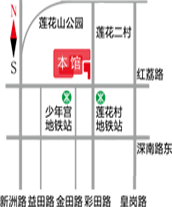
- Shenzhen has a historical opportunity to create new cultural traditions - Interview with Director An Yuanyuan of the Literature and Art Department of the Art Department of the Ministry of Culture
-
Guan Shanyue
Question: As an exhibition system, the National Art Exhibition has been held for ten times since the founding of the People's Republic of China. This year is the eleventh edition, and some people say that this exhibition system is outdated and cannot reflect the face of contemporary Chinese art. As an official of the organizing organization, how do you view this issue.
Answer: If any activity or mechanism has existed for 60 years, there must be a rationality for its existence. Since the founding of the People's Republic of China, we have continuously launched art masterpieces that reflect the characteristics and spirit of the times through national art exhibitions. The achievements of this work are evident to all. Many representative works in contemporary art history have emerged from national art exhibitions. This mechanism also reflects the cultural orientation of our country in different historical periods. At the end of the day, artistic works are a form of emotional expression after selection. Artists express their views through specific artistic images by judging and choosing the pulse and spirit of the times. Therefore, these representative works can also become visual memories of a certain era.
Of course, the national art exhibitions themselves are also constantly adjusting, which is not only related to the macro development of the country, but more importantly, to the development and changes of the art categories themselves. For example, adding an "art and design" exhibition area is based on the actual needs of design development. The mechanism of national art exhibitions is also constantly being adjusted.
Q: I heard that the Ministry of Culture once decided to withdraw from hosting a national art exhibition?
Answer: It's not that the Ministry of Culture wants to withdraw, but according to the adjustment plan of the Propaganda Department for literary and artistic award activities, the National Art Exhibition has been transferred to the Federation of Literary and Art Circles. Later, various parties have reported that such adjustment is not conducive to the sustainable development of the national art exhibition system. We will report to our superiors that in order to effectively implement the Scientific Outlook on Development through learning and practice, the Ministry of Culture will continue to host it. The addition of the China Federation of Literary and Art Circles is also very good, with more resources.
Q: There is a prevailing view that holding art and design exhibitions within the framework of the Ministry of Culture and the China Artists Association does not have corresponding authority, as the main resources of design are concentrated in industry associations of various design categories. What do you think?
Answer: In addition to necessary practical functions, the value of design should also be reflected in bringing aesthetic pleasure to people, so design also belongs to the category of aesthetics. If Shenzhen transforms from a small fishing village to a modern city, it not only needs to develop the economy and meet material needs, but also needs to develop culture and art to meet people's spiritual needs. In the process of manufacturing objects, ancient people not only demonstrated the function of manufacturing, but also showed respect for objects. The so-called "unity of heaven and man" ideology also reflected the emotional communication between people and objects, as well as between objects and objects, ultimately achieving aesthetic goals. Design can be said to have expanded the field of contemporary beauty to a greater extent, and through its practical functions and aesthetic value dissemination, it has become a shared achievement among humanity. We cannot sever the blood relationship between art and design, as their technological foundation for creating aesthetic value is common.
Culture and art are expressions of human aesthetic emotions. I strongly agree with Mr. Cai Yuanpei's viewpoint that aesthetics replace religion, because only aesthetics can have a redeeming and educational effect on life, just like religion, and can cleanse the soul. There are some things in modern art that are difficult to call "beauty" and lack moral constraints, making it difficult to call "good". Such art is difficult to call "art", and of course, it is difficult to enter the platform of national art exhibitions. When Chairman Mao wrote the name of the Central Art Exhibition Hall and directly referred to it as "China Art Museum", the meaning was even more profound. I think Chairman Mao respected Mr. Cai Yuanpei very much during his time at Peking University, and I think he also agreed with the idea of "replacing religion with aesthetic education.". The power of beauty transcends ethnicity and class. When faced with a classic work, whether you are rich or poor, you will be equally moved.
Q: The National Art Exhibition Design Exhibition has been held for three sessions. What changes have occurred compared to the previous two sessions?
Answer: The first design exhibition should be exploratory, with simpler changes in categories and styles. It has now become increasingly diverse and more extensive. In the past, many works had traces of imitation, but now many authors focus on personalized expression, especially the ability to consciously integrate national culture and spirit into their works. This is also a manifestation of China's mature art and design. This transformation also corresponds to the past where our industry was mainly focused on processing and manufacturing, but now emphasizes independent innovation and the need to create our own brand. These changes are closely related to the development and changes in society in recent years. In short, I believe there has been significant progress.
Q: You are very interested in art activities in Shenzhen and familiar with Shenzhen. Please share your views on art in Shenzhen. What is your evaluation of Shenzhen's plan to hold an international design forum on the platform of the National Art Exhibition and Design Exhibition, attempting to push the achievements of the National Art Exhibition into a new space for international cultural exchange?
Answer: I heard that we are going to do an international forum. Shenzhen has an open demeanor and an international perspective. Its ability to become a "design city" recognized by UNESCO also reflects its openness and cultural confidence. The reason for lack of confidence is often due to a lack of correct understanding of one's own strengths and weaknesses, and Shenzhen is very clear in this regard. Shenzhen is a sunny city, young and positive, but not a barren land of culture. People can always find what they like here. Although there are no Terra Cotta Warriors, Qin bricks and Han tiles in Shenzhen, there are many art museums in Shenzhen, and each one has its own characteristics. For example, this art and design exhibition is jointly organized by the Guan Shan Yue Art Museum and the Hua Art Museum. This is very similar to the United States, which does not have pyramids or millennium cathedrals, but has numerous art galleries and museums, so it also has cultures from all over the world. Society needs diverse and rich cultures, just as nature needs diverse and diverse species to develop healthily through inclusiveness and accumulation. Shenzhen has this kind of cultural inclusiveness, where traditional culture and new cultural forms can develop in parallel. Therefore, Shenzhen has a historical opportunity to create new cultural traditions.



